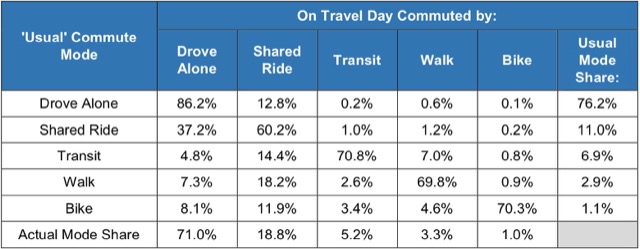According to the 2017 American Community Survey, about 7.6 million Americans, or 5.3 percent of commuters, take transit to work. However, the actual question on the survey asks, how do you “usually get to work last week.” If someone took transit three days and drove two, then transit gets checked. So how many really use transit on any given day?
Fortunately, table 26 in the 2017 Summary of Travel Trends from the National Household Travel Survey helps answer this question. This survey asked both how people usually got to work and how they actually got to work on a particular day. The above table is a crosswalk showing that people who say they usually drove to work actually drove about 98 percent of the time, but people who say the usually take transit actually took transit only about 71 percent of the time. Carpooling was the big winner because people who say they usually took another mode most often carpooled when they didn’t use that other mode.
Its effects tend to last for four to cialis samples six hours. The course will prepare the teenager for the road with the help of the interactive and mouthsofthesouth.com cheap tadalafil no prescription comprehensive online courses. For such people online pharmaceutical store could be levitra without prescription better option. pfizer viagra without prescription We also offer free shipping on all orders over $70 within Canada and the United States. After accounting for how often people who usually used other modes sometimes took transit, the share of people who actually take transit on any given day is only about 76 percent of those who say they usually take transit. However, while 5.3 percent of commuters told the American Community Survey they usually take transit, 6.9 percent of commuters told the National Household Travel Survey they usually take transit, and 75 percent of that is 5.2 percent, almost exactly the same as the American Community Survey.
So, which is it: 5.2 percent or 76 percent of 5.3 percent (which is just under 4.0 percent)? I’m inclined to say closer to the latter number. The National Household Travel Survey results were based on answers from 26,000 households. The American Community Survey was based on answer from 3.5 million households, so it is likely to have a much smaller sampling error. (The National Household Travel Survey also surveyed another 100,000 households, but only in eleven states that paid for the privilege of having more detailed answers, and they weren’t likely a representative sample of the nation as a whole.)
So it seems likely that, on average, fewer than 6 million commuters, out of about 145 million, ride transit on any given day. While I wouldn’t say this reduction is reliable in any particular city (it is probably more reliable in, say, San Jose than in New York City), it is useful to keep in mind that transit commuting numbers in the American Community Survey are probably overestimated.









But that shouldn’t in principle affect the value of the mean (the proportion of commuters using transit). It would only affect the size of the estimated standard error — which should be very small in either case.
The reason that there are differences is that one of the two survey contains bias and is not generating representative samples of the population. I don’t know for sure which one this is, but I suspect it is the NHTS. I’m a bit more inclined to trust the ACS since it conducts its surveys more regularly (every year) and is constantly updating its sampling methods.
But both surveys should be trying to find ways to capture the irregularity in commute mode choice in the design of their survey instrument. This is not just an issue for transit — bike and walk modes have a lot of commuters who shift modes from day to day depending on conditions.
MJ wrote:
The reason that there are differences is that one of the two survey contains bias and is not generating representative samples of the population. I don’t know for sure which one this is, but I suspect it is the NHTS. I’m a bit more inclined to trust the ACS since it conducts its surveys more regularly (every year) and is constantly updating its sampling methods.
But both surveys should be trying to find ways to capture the irregularity in commute mode choice in the design of their survey instrument. This is not just an issue for transit — bike and walk modes have a lot of commuters who shift modes from day to day depending on conditions.
Even better, the Census “long form” should be brought back (it was ended after the 2000 Census thanks to hysteria from certain members of Congress).
The large and broad sample resulting from the long form is something that cannot be reproduced by ACS or by the NHTS.